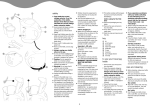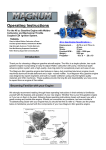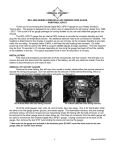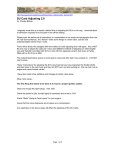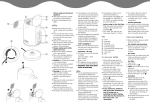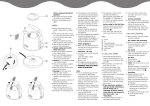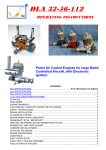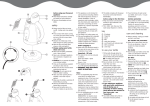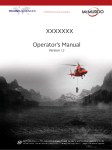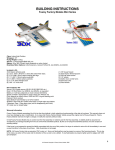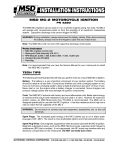Download Newbies GUIDE to GIANT SCALE GAS ENGINES GUIDE TO GIANT
Transcript
RC Aero Products LLC Newbies GUIDE to GIANT SCALE GAS ENGINES By Bob Pastorello This is a living document, that will be updated whenever the need arises. Many of these hints are “common sense” based upon years of experience. They are not hard to learn, not difficult to remember, and easy to use. These hints will make your RC flying safer, a lot more funner!!! So... as a "newbie" to Gas. Some things in general that you must keep in Mind and Learn About Doing. The following guides are not in any particular order. GUIDE TO GIANT SCALE GAS ENGINES 1. All tank and plumbing accessories must be " gas " rated. Dubro brown color stoppers are the "standard". Yellow Tygon is widely used. Clear tubing is crap. All fittings need to be "secured" over their attachment barbs. All smooth brass tubing needs some kind of bump, solder blob, or barb to keep Tygon on, as it swells in use. BEFORE it gets rigid and brittle with age. NORMAL. 1a. Klunks and filters.....gotta have 'em someplace. Klunks in the tanks that are like the little Walbro "felt clunks" in your weed eater work REALLY well. So do more exotic ceramic particle filters. Gotta have a klunk. Gas should be filtered in the jug, too, before it gets INTO your airplane. And yes, tanks only need two lines.... vent to atmosphere and line to carb. You can use a tee with a fuel dot to fill and drain the tank. It will work forever. You also can use three lines, but that gets a little more complicated. Use filters. USE FILTERS. Note: If a two line system is used make sure the tank is not lower than the fuel er you use, If it is the fuel will run out of the line back into the tank and then you have to pump the fuel back to the carb and there will be air in the line. Making the first start after fueling a little harder. 1b. Pulse Lines - MANY gassers have a piece of Tygon fuel line running from a fitting on the crankcase or intake adapter to an inlet pipe on one of the "sides" of the carb. This line is NOT for gas . It must not be kinked. It cannot have holes. If not hooked to the pulse line on the carb, the carb will not pump. Ever. When in doubt, call the manufacturer. Most of them ship their engines with the pulse lines already properly connected. Sometimes they even have manuals with pictures in them that MAY show this line and its’ fittings. 2. Every engine with a Walbro or "clone" carb MUST HAVE their Low and HIGH speed needles readjusted from factory settings to get GOOD performance. EVERY ENGINE!!! 2a. Walbro carbs (and other similar) have PUMPS. Rocking the prop back and forth or flipping it with fuel will PUMP the head full. Spark doesn't work under fluid. The tank can be a long way from the carb, and that's okay. As you rock the prop, watch the air bubble/fuel move up the line. If the bubble isn't moving....the pump isn't pumping. Get the pump wet inside somehow. Fact. 3. Breaking an engine in on the ground is generally not a real good idea. Use the manufacturer's recommended oil ratio for starters, get a couple tanks (or less) through the engine to make sure everything is okay, then go fly the damm thing so it will have SOME form of cooling air over it. 4. Spark plug cap fittings usually fit very tightly if they are the "push on" type, and you will have to push HARD. It's normal. If the plug cap isn't on correctly, it will not run right. EVER. And you'll get unreliable starting, running, and radio interference (all not-good things). www.rcaer.com [email protected] Tel: 888.239.8593 Giant Scale Engines and Products that Surpass Expectations Page 1 of 6 RC Aero Products LLC 5. Prop drilling - if you have a jig, use it. If you don't, use the prop washer as a guide and try to get straight holes. ALWAYS balance a prop before using it. 6. Most carbs will require you to modify the throttle arm to be "user friendly" for our pushrod/ball link setups. Get over it. It's the way it is. Use a short servo arm to attach to the crappy little plate they supply on the throttle butterfly shaft. Use ball links and very rigid pushrod setups with GOOD servos. 7. Remove and toss the "stop screw" on the throttle arm plate, then unhook the little spring that pulls the butterfly closed, unless you want your throttle servo under constant load/tension. Do NOT REMOVE THE SPRING. 8. Electronic ignitions work wonderfully, if they are getting power. Use a reliable battery with the voltage rating and milliamp hour rating that the manufacturer recommends. WHY??? Because if you toast the ignition from incorrect battery usage - YOU WILL BUY THE REPLACEMENT. If they say nothing, go with a 4 cell 1100mah NiCad, or NimH, or a 5 cell system on a GOOD regulator. Not recommended for newbie s. Get some experience with this area. Always use a switch, and setup throttle so you can kill it. Generally speaking, there are "good" ignitions, and there are "cheap" ignitions, but not so much "Good and Cheap". Ya gets what ya pays for on this one!!!! 8a. Ignitions all have three chunks of wire. ONE, the spark plug lead, also contains the "ground", and must make contact with the outside of the plug hex (where your socket wrench grabs the plug). It can't have holes, or cracks, and should always be prevented from rubbing on ANYTHING. TWO - "Power", usually a "female" battery-type connector with a red and black or red and white wire/connector. This is where the "OUT" of your switch provides power to the ignition. NEVER get the red and other color mixed up ever!!! THREE - the "sensor pickup" - usually a black/white/red (or similar) wire that connects to the thing that is mounted up near the prop hub (on most engines). This is the "hall switch", and picks up the rotation of the prop hub by sensing a magnet when it rotates past the face of this switch. ALL three wires have to connect, and the polarity of these three wires can never be wrong, either. The ignition senses the magnet rotating past the switch on the hub/crankcase to figure out when to send the spark to the plug. It only "knows" when the magnet has passed it. ALL of these work the same way. Rotating the hub magnet past the hall sensor/switch means that the IGNITION **WILL FIRE THE PLUG** if it has power. Many people with injured fingers thought an ignition was OFF when it wasn't and found out by casual flicking of a "hot" prop. The ED department visit usually costs more than an engine. AVOID this, always. Treat a gas ser with an ignition attached as if it is HOT, 100% of the time. 9. In general, a new carb will not pump if it has been dry for awhile. Period. Get some gas into the thing by normal "priming", close the choke, flip through a few times, ignition on, throttle at high idle. Engine pops starts, dies, open choke, flip till starts. RESTRAIN you AIRPLANE while doing this. ALWAYS. 10. These gassers need GAS . Not some other kind of make-believe fuel. If yours has ethanol, it will be okay. 95% of our engines will do just fine on regular unleaded 87 octane pump stuff. They also have to have OIL. Nearly all of these need about 30 or 32:1 ratios for their first starts. That's 4 oz to a gallon. Easy to remember. Won't hurt the engine. Use a good quality oil for 2 strokes. If in doubt, call the ENGINE seller about ratios and types. 11. No Metal to metal from the servo to carb. Use nylon rod and sleeve. 12. Place the Rx as far as practable away from the CDI as possible. 13 - Whoo - black Friday - don’t fly on this day. 14. If it isn't running right on the ground, it will NOT improve in the air. ADJUST IT!!! And do that ONLY after it is at its "normal" operating temp. www.rcaer.com [email protected] Tel: 888.239.8593 Giant Scale Engines and Products that Surpass Expectations Page 2 of 6 RC Aero Products LLC 15. More prop does not mean more power. It means more load, and generally that isn't a good thing. EVERY prop change on EVERY engine will need re-adjustment. PERIOD. 16. If someone helps you and things get worse with your engine - get a different helper. ALWAYS. 17. Mufflers - nearly all of them are NOT; they are exhaust cans with diverter outlet tubes. They are usually louder than you think. If you want quiet, you need a canister, period. Not necessarily for newbies. 18. Install mufflers with no gasket; use a thin film of Permatex High Temp Permagasket on the face of the muffler flange. Put RED "permanent" or "high temp" Loctite on the screws, and tighten them. Tightly. 19. If you have to use a Pitts muffler, brace the canister part to the engine/firewall with a bracket or strap of some kind. Tighten the muffler to the engine exhaust THEN install the strap/canister attachment. Don't do it the other way. 20. Smoke is not for a newbie. If you must smoke, get help with it, as you've instantly doubled your plumbing complexity, tanks, added weight, electronics, etc. If you have to have it, post here on "How to Setup Smoke". It works great and looks like a million $$$ but most folks don't mess with the mess. 21. Spark plugs. These are not glow plugs. They need ignition sources. They have to be properly gapped. They should not be oily-looking, fouled, or have shiny metal flakes on the porcelain. ANY of these things are symptoms that something else is wrong. 22. If your engine doesn't "take throttle" (hesitates), the low end is probably lean. If it "takes throttle", but bogs down, coughs, sputters, etc. it is low end RICH. NO doubt about these. Properly-adjusted gas ser carbs operate very well. Poorly adjusted ones will make you insane. 23. If you have been flipping until your arm is ready to fall off.....go back to the first post on this thread. SOMETHING ain't right. All of these engines need air, gas , compression, and ignition. Given all of them in the proper portion and time, these engines ALWAYS start. If they do not....SOMETHING IS NOT 24. Gassers vibrate. Period. Firewalls must be STRONG, and pinning around their circumference with wood dowels or epoxy/nails is a good practice. Pulling the engine box off an ARF is easier to do than you think. 25. Your engine will probably require "standoffs". Measure your ARF from intended prop spinner back plate to firewall. Deduct the overall "mounting length" of your engine, plus 1/8". Whatever is left is the "standoff". You can buy metal ones, or make your own out of hardwood dowels, whatever. BUT - they have to mount real solid-like. Find sources of long #10-32 hex head bolts, split washers, flat washers, fender washers and nylon-insert Locking nuts. USE them. It is a BAD plan to have an engine come loose. 26. Allow "exit area". You cannot avoid it. You either make holes to let LOTS of air out of your cowling/nose, or you cook your engine. Period. If you are able to do it, direct air by dams or ducting directly over the fins of the engine, THEN to the "big exit area". If you hover, or do strenuous 3D....skip this step and you'll cook the motor, probably seizing it up at a lowaltitude hover by overheating, thereby crashing your airplane ALSO. 27. Props - the most important accessory for your engine. Bad props give sucky performance, break easily, or disappoint you in their performance. Any good prop of the manufacturers rated size will make you a happy gas ser. 27a. Prop Balancing - probably an oft-ignored and vitally-important "thing" for gas ser guys. A good balancer is essential. A bad balancer is a waste of money. I prefer the Dubro Spin balancer....very sensitive. Blades are balanced by lightly spraying the back of the blade with clear spray lacquerlightly...until blades balance. If blades are balanced, but moves anyway, check the hub. Put the prop on the balancer with blade vertical. Release blade. Watch top blade....if it falls LEFT (as you're looking at it) www.rcaer.com [email protected] Tel: 888.239.8593 Giant Scale Engines and Products that Surpass Expectations Page 3 of 6 RC Aero Products LLC then the RIGHT hub needs weight, and vice versa. Weight on the hub is the curly Velcro, ca'd in place, a few drops of thick ca, then kicker. Recheck balance. Keep at it until the prop remains motionless wherever you position it on the balancer. THAT is perfect balance. Takes about a half hour on a 22", more on bigger. DO IT. 28. RPM readings. Nearly meaningless for one user to compare to another user. Even if using the same prop. Carbs are very sensitive and being off the sweet spot by 1/16th turn on the H needle can make a big difference in tach readings. Plus, most tachs are semi accurate, part of the time, and light/angle sensitive all of the time. Unless you know me, and how I I tune, my altitude, air density, oil mix ratio, type of oil, and heat temperature....my peak rpm is of no consequence to you except for "ball park", and it's a helluva big park. Most 50cc gas sers and above should be somewhere around 7000 with the "stated" prop from the manufacturer. Larger displacement, lower peak rpm. That's how it goes. 29. Frequently check your ignition battery voltage. Under load, if possible. An ignition battery that is losing its guts will create bizarre unreliable and misfiring engines. 30. If your engine was fine yesterday, and today it's NFG, then *something* changed. Find what changed, and fix it. Don't jump to conclusions and speculate. Work through the systems. Start at the tank, work through the plumbing. Start at the battery, work through to the plug, start at the servo, work through to the butterfly. Only a VERY few, and "special" engines are actually sold with Gremlins built into them. Usually they have already been owned by someone who couldn't find and kill the gremlin, so you got it. Think of a finicky motor as a PC virus....there is a solution....you just have to find it. 31. When you have a new engine....buy a new (correct) spark plug. And as soon as you can afford it a Spare Ignition, and a Hall Sensor/switch. Spare carb if you aren't a "carb tweaker". Carb rebuild kit whether you are or are not. Buy replacement prop bolts, and be sure to use split and flat washers so the prop washer doesn't get all boogered up. Many manufacturers don't know about this yet, so they don't include screws long enough for thick hubs and spinner back plates, much less the split and flat washer. It is worth investing in. 32. Buy extra metric screws and ball drivers. NEVER trick yourself into believing that a 10-32 is the same as a 5mm. They ain't. 33. ALWAYS provide for some form of emergency engine/ignition cutoff. At a minimum, install an external switch that cuts off power to the ignition. Better yet, add to that an internal ignition cutoff, that is connected to a spare channel on your radio. Optical remote cutoff modules from SmartFly or other providers, work really well. Make sure the assigned switch is out of the way, so you do not hit that switch accidently while flying. 34. Tygon tubing, of the type mostly used for gas engine in model airplanes, degrades over time. Check the tubing on any airplane you have acquired, especially at the ends. The piece of tubing inside the tank that is attached to the clunk and dipped in fuel, will likely get hard in a year, loose its flexibility and could be the source of fuel draw issues if not checked. 35. OIL - It is vital that you protect a gas ser with the RIGHT kind of internal oil film for operation. Too little oil and it will die a quick and horrible death. Too much oil, and you plugs and airplane covering will look "ugly". It is never a good idea to use an oil that intentionally introduces abrasives to "wear in" an engine. Let a proper amount of good oil do that during FLYING !!! Everyone has their preferences; some are based on experience, some on knowledge, and even fewer on BOTH. Ask the person with BOTH what they recommend. ALWAYS pay attention to what the company that is providing WARRANTY on your engine says about oil. Do it "their way", or be prepared to fix the engine yourself for ANYTHING even remotely-oil-related. www.rcaer.com [email protected] Tel: 888.239.8593 Giant Scale Engines and Products that Surpass Expectations Page 4 of 6 RC Aero Products LLC 36. KILL SYSTEMS - Gassers, because of their power (and usually size of airplane) **SHOULD** have some sort of a "kill device" either mechanical, or electrical. In general, most folks agree that a transmitteroperated kill switch is a good safety device. If airborne, with a typical large tank, your throttle servo fails or disconnects, you either land hot and break something, or fly around risking killing batteries. If you have a switch to flip that chokes the engine, or removes power from the ignition, YOU can decide when to land safely. a. Choke Servo - this involves hooking up a choke servo to an extra channel, and assigning to a switch or lever on the TX that closes the choke when you actuate it. Overly-rich, with air cutoff, the engine will die quickly. Pros and cons to this system. b. Electronic Kill Device - this involves an electronic switch that is operated by a spare RX channel, activated by the TX that cuts off power to the ignition module. These are nearly always installed "after" the on-board separate ignition switch, and "before" the module in the power lead. Usually optically-coupled electronic switches, they don't induce any harmful interference when properly installed. Lots of these available. If going this way, ask around your area or on RCU to help make your decision. Whatever you do, please ALWAYS consider the safety benefit of being able to shut off your gasser when YOU want to. It is a vital element of overall RC safety, IMO. 37. Throttle Linkage, Trim, and Adjustment - Our carbs are really intended to be nearly "full on" a majority of time...not to be continually varying them in the middle range which is our main usage. So, to get things "right", it's important (maybe VITAL) to properly setup the mechanical *and* electrical setups of the throttle and carb arms. Here's what I suggest: Method A - Basic Approach Full DOWN throttle trim is "cut-off", closing the carb completely. This is the full ATV adjusted on the bottom end. I set this by fine tuning the ATV so the control rod isn't binding the servo, but the throttle plate is completely closed. Middle "detent" throttle trim is the "landing" and "taxi" trim setting. That is determined by a couple of things that inter-relate. First, in the System setup screen, set the Throttle trim authority to 50%. It is far too sensitive otherwise, for a gas ser. Then, assuming that you've set the carb arm length to be slightly more than the servo control arm take off length, the 'half trim' should be where the plane will sit motionless when engine is fully warmed up. Finally, set the Throttle Curve function ONLY if you cannot get the low end sensitivity/linearity mechanically. Reason I suggest that is that the mechanical rotational and linear geometry of the arms can go a long way toward getting it "right". Finally, the "full" trim is the "hot restart" setting, because my carbs tend to be leaner on the low end, so a hot restart needs just a bit more travel. Method B - The Real Deal Now - the "real deal" is to get the correct pushrod length. There are, again, many opinions on these mechanical setups, but I'll just describe mine, as it is consistent, repeatable, and reliable. Use a Servo arm where the "take off" or "ball link attach" point is about 5/8" from center of shaft. Purpose of that distance is to ensure that you'll be close to needing 100% ATV on both ends of the throttle channel, making the "clicks" of throttle less profound. You don't want big differences per click, and a longer arm will be too much. Shorter arm requires too much ATV diddling, and introduces mechanical expo which may not be in the "correct" direction. On the Carb, use an arm with the ball link take off point at 3/4" from shaft center. This permits more rotation of the arm, and helps solve sensitivity issues mechanically at the carb. Walbro carbs are www.rcaer.com [email protected] Tel: 888.239.8593 Giant Scale Engines and Products that Surpass Expectations Page 5 of 6 RC Aero Products LLC HORRIFICALLY non linear and overly sensitive... Now, with both arms installed, set your ATV to about 90% on both extremes. Open the carb arm to "FULL THROTTLE" (where it hits the mechanical full throttle stop), and move throttle stick to FULL throttle. Measure the straight line distance between the centers of the ball link attachment points. Now, go to full CUTOFF low throttle and low trim, and rotate the carb arm to FULL CUTOFF. Measure that straight line difference. If not the same as the full throttle length, take the average. Create a Carbon fiber, or stiff metal pushrod of EXACTLY that length. Install. You will be very close to "perfect". Tweak the ATV end points as needed, you perhaps will need to adjust the Throttle trim authority again, but you will be very close to a good linear setup. If it isn't like you want it, THEN setup the Throttle curve function, but not until after all the mechanical stuff has been taken care of. 38. Using Stuff NOT from the Manufacturer - in general, unless you have a field full of qualified and experienced gas -helpers, make your FIRST gas ser install **exactly like the engine manufacturer tells you to do it*** This helps you in several ways....1) you'll be doing what the folks who will WARRANTY the thing have said to do....2) if you have to call them for help, they will know how your system is setup and it will be easier on both of you for troubleshooting....3) sometimes stuff that folks buy as 'add-ons' to make things better, easier, neater, really do NOT, and then as a new user, you have inadvertently placed unknown variables into the "why doesn't this work?" equation. It is just really easier, the FIRST time, to "do it the easy way", and "follow the instructions", as much as that advice may seem counterintuitive to our knowledge and reason. 39. If you have read this thread this far, please go back to the start and remind yourself of the "basics". When things don't go well, most of us immediately begin jumping on "device or component failure". The sad truth, and I am absolutely including myself in this, is that the MAJORITY of time it's OUR failure to seek, read, and heed qualified guidance. We're just too proud since all of us have had chainsaws and weed eaters since we were kids. They "all work the same"...... NOT!!!!!!!!! www.rcaer.com [email protected] Tel: 888.239.8593 Giant Scale Engines and Products that Surpass Expectations Page 6 of 6








